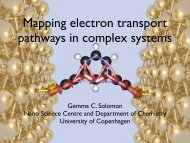Mapping the electronic resonances of single molecule STM ... - AtMol
Mapping the electronic resonances of single molecule STM ... - AtMol
Mapping the electronic resonances of single molecule STM ... - AtMol
Create successful ePaper yourself
Turn your PDF publications into a flip-book with our unique Google optimized e-Paper software.
<strong>Mapping</strong> <strong>the</strong> <strong>electronic</strong> <strong>resonances</strong> <strong>of</strong> <strong>single</strong> <strong>molecule</strong> <strong>STM</strong> tunnel junctionW.–H. Soe 1 , C. Manzano 1 and C. Joachim 1,2 1IMRE, A*STAR, Singapore2GNS-CEMES, CNRS, France
outline• <strong>STM</strong> with <strong>single</strong> <strong>molecule</strong>• molecular states imaging• simple to complex
Pentacene/Cu (J.Lagoute et al. PDI)Pentacene/NaCl/Cu(J.Repp et al. IBM)*Neaton et al. PRL97 (216405) 2006
Pentacene/Cu (J.Lagoute et al. PDI)Pentacene/NaCl/Cu(J.Repp et al. IBM)Cu Ag AuNaClSi-Hourplayground!*Neaton et al. PRL97 (216405) 2006
HOMO@NaCl (IBM)LUMO@NaCl (IBM)
3D <strong>the</strong>oretical imagein <strong>the</strong> gap(HOMO & HOMO-1)HOMO-2HOMO-1HOMOESQCSUMexperiment
Pentacene• D2h symmetry• each state: well separated• no degeneracyCu-Phthalocyanine• D4h symmetry• each state: well separated• two states: degenerate(LUMO & LUMO+1)
C4ground state1st excited statesC4C4 C2 C2HOMOLUMO & LUMO+1(degenerated)
ground state
1st excited statesgold surface plays as a jellium,i.e. not considered its structural factor.thinking aboutadsorption sitesadsorption sites
adsorption sitesfcc(111) grid
C2C4950mV1000mV1100mV
C2C4950mV1000mV1100mVbridge-site or on-top site
18E. R. Johnson and o<strong>the</strong>rswater (Esler et al. in press) typically show a shock downstream <strong>of</strong> <strong>the</strong> ridgefollowed by a wavetrain <strong>of</strong> finite-amplitude Poincare waves <strong>of</strong> limiting amplitude(Shrira 1981, 1986; Grimshaw et al. 1998b). Numerical integrations (not shownhere) <strong>of</strong> a fully nonlinear, finite-volume, shallow water model show shocksappearing behind obstacles in non-dispersive rotating flows, providing fur<strong>the</strong>revidence <strong>of</strong> <strong>the</strong> nonlinearity <strong>of</strong> <strong>the</strong> sharp-crested waves <strong>of</strong> figure 5. Theexperiments <strong>of</strong> figure 5 also show that rotation confines <strong>the</strong> wake to within adistance <strong>of</strong> order <strong>the</strong> internal Rossby radius, c 0 /f for critical speed c 0 and Coriolisparameter f, <strong>of</strong> <strong>the</strong> axis. More rapid rotation confines <strong>the</strong> wake more closely to<strong>the</strong> axis and experiments for rotation periods <strong>of</strong> TZ60 s and TZ90 s (so fZ0.06,0.08 s K1 ), giving Rossby radii <strong>of</strong> 50 and 75 cm, gave a clearly visible wake withlittle signature away from <strong>the</strong> axis and so not shown here.The presentation <strong>of</strong> <strong>the</strong> experimental results as a fixed wave pattern travellingwith <strong>the</strong> obstacle assumes that <strong>the</strong> flow has had sufficient time to become steadybefore <strong>the</strong> waves arrive at <strong>the</strong> probe spar. The obstacle reaches <strong>the</strong> spar in <strong>the</strong>middle <strong>of</strong> <strong>the</strong> tank in non-dimensional time in <strong>the</strong> range tZ3.8–6.4, althoughwaves forming <strong>the</strong> outer edges <strong>of</strong> <strong>the</strong> pattern can take twice as long to arrive.Some indication <strong>of</strong> <strong>the</strong> extent to which this is sufficient for nonlinear bow wavesto develop may be gauged from figure 9, which shows <strong>the</strong> temporal development<strong>of</strong> <strong>the</strong> bow waves in <strong>the</strong> case <strong>of</strong> <strong>the</strong> non-rotating multiple bow wave numericalsolution with hZ5 cm, UZ13.5 cm s K1 . The steady state for this experiment isshown in figure 7 (right panel). Figure 9 shows <strong>the</strong> wavefield at tZ2, 4 and 8. AttZ2 a <strong>single</strong> bow wave has separated from <strong>the</strong> dispersive wake, while by tZ4 asecond bow wave has begun to separate. It is not until tZ8, however, that <strong>the</strong>bow wave pattern begins to resemble <strong>the</strong> final state shown in figure 7 (rightpanel). It is clear, <strong>the</strong>refore, that although significant development <strong>of</strong> nonlinearbow waves has taken place by <strong>the</strong> time <strong>the</strong> wave pattern passes <strong>the</strong> probe spar in<strong>the</strong> experiments, it is by no means certain that <strong>the</strong> bow wave pattern hasattained its steady state. Experiments intended to detect multiple bow wavepatterns would thus need careful design to ensure that t is sufficiently large whenmeasurements are taken.This work was funded by <strong>the</strong> UK Natural Environment Research Council GrantNER/A/S/2000/01323 and under <strong>the</strong> European Union contract HPRI-2001-CT-00168, ‘Accessto Research Infrastructures’ <strong>of</strong> <strong>the</strong> program ‘Improving Human Potential’. The authors aregrateful to Henri Didelle and Samuel Viboud for <strong>the</strong>ir expert technical assistance.ReferencesAkylas, T. R. 1994 Three-dimensional long water-wave phenomena. Ann. Rev. Fluid Mech. 26,191–210. (doi:10.1146/annurev.fl.26.010194.001203)Benjamin, T. 1967 Internal waves <strong>of</strong> permanent form in fluids <strong>of</strong> great depth. J. Fluid Mech. 29,559–592.Burk, S. D. & Haack, T. 1999 The dynamics <strong>of</strong> wave clouds upwind <strong>of</strong> coastal orography. Mon.Wea<strong>the</strong>r Rev. 28, 1438–1455.Davis, R. E. & Acrivos, A. 1967 Solitary internal waves in deep water. J. Fluid Mech. 29, 593–607.Durran, D. R. 2000 Small-amplitude coastally trapped disturbances and <strong>the</strong> reduced-gravityshallow-water approximation. Q. J. R. Meteorol. Soc. 126, 2671–2689. (doi:10.1256/smsqj.56903)Proc. R. Soc. A (2006)
LUMOLUMO+1
Pentacene• D2h symmetry• each state: well separated• no degeneracyCu-Phthalocyanine• D4h symmetry• each state: well separated• two states: degenerate(LUMO & LUMO+1)
Pentacene• D2h symmetry• each state: well separated• no degeneracyCu-Phthalocyanine• D4h symmetry• each state: well separated• two states: degenerate (LUMO & LUMO+1)• D6h symmetry• some states: close• degenerateHexabenzocoronene(HBC)
2nd excitedLUMO+1 statesground stateHOMO1st excitedLUMOstates
summarywe showed• from Pentacene, <strong>the</strong> way to disentangle <strong>the</strong> MOcomponents in higher resonance molecular states.• from Cu-Phthalocyanine, <strong>the</strong> tip-<strong>molecule</strong> interactionscapture <strong>the</strong> MO components <strong>of</strong> <strong>the</strong> molecular states asa mixture <strong>of</strong> different phases and weight contributions.• from HBC and its dimer, a STS resonance results froma complex contribution to <strong>the</strong> local conductance <strong>of</strong>many molecular states.
MPIP, GermanySynth.Mol.> Xinliang Feng& Klaus MuellenCEMES-CNRS, FranceESQC> Maricarmen GrioliaPM6-MO CI> Mohamed HliwaChristian Joachimthanks!IMRE, Singapore<strong>STM</strong> Exp.> Carlos ManzanoHon Seng Wong



